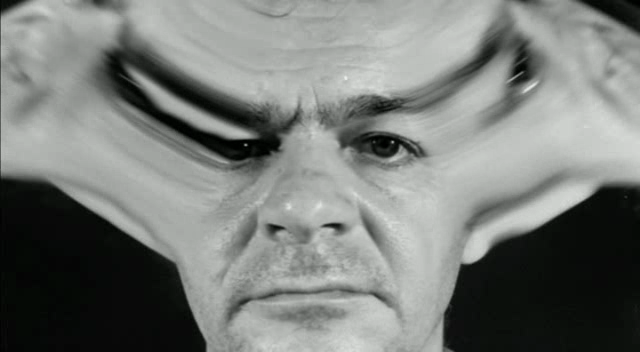Blu-ray: Henri-Georges Clouzot's Inferno | reviews, news & interviews
Blu-ray: Henri-Georges Clouzot's Inferno
Blu-ray: Henri-Georges Clouzot's Inferno
Clouzot's famously unfinished film, dissected with affection

Watching what remains of Henri-Georges Clouzot’s Inferno (L’Enfer) serves to remind us just how good his earlier work was. Inferno marked the beginning of the end, its shambolic production beginning Clouzot’s descent into obscurity.
The hugely anticipated Inferno was started in 1964, four years after Clouzot’s previous film, the Brigitte Bardo-starrer La vérité, which had been a huge box-office success. What was potentially an intimate thriller about a jealous husband and his younger wife became a casualty of directorial hubris. Columbia Pictures recklessly gave Clouzot an unlimited budget, allowing him to hire three crews and 150 technical staff. Meticulously detailed storyboards were drawn up, with colour-coded notes signalling levels of characters’ emotional stress. Weeks were spent creating eye-popping test footage intended to suggest the husband’s mental collapse.
 These sequences make the documentary mandatory viewing, a parade of unhinged psychedelic visuals which enthral as much as they bewilder. We get backwards shots of a luminous Romy Schneider (pictured right) exhaling smoke, and extraordinary footage of her and co-star Serge Reggiani illuminated with rotating lights, their faces seemingly melting and reassembling. Schneider even gets to explore the erotic potential of a Slinky. Leading avant-garde composers assisted with the sound design, and Clouzot’s immaculate graphic notation is a joy to behold.
These sequences make the documentary mandatory viewing, a parade of unhinged psychedelic visuals which enthral as much as they bewilder. We get backwards shots of a luminous Romy Schneider (pictured right) exhaling smoke, and extraordinary footage of her and co-star Serge Reggiani illuminated with rotating lights, their faces seemingly melting and reassembling. Schneider even gets to explore the erotic potential of a Slinky. Leading avant-garde composers assisted with the sound design, and Clouzot’s immaculate graphic notation is a joy to behold.
Exterior scenes on a lake would have had their colours reversed, turning the water blood-red – meaning that the actors had to wear blue make-up and lipstick. You sense that the famously well-organised Clouzot was out of his depth. One collaborator recalls the director seeming “a bit Hollywood”, lamenting that “he used to be so efficient.” It’s a miracle that the collapse didn’t come sooner: poor Reggiani (pictured, distorted, below left), presumably exhausted after being made to run for miles each day in blazing heat, exited after a few weeks, allegedly suffering from "Maltese fever". Clouzot vainly tried to secure a replacement, shooting endless retakes in the knowledge that the lake was about to be drained for a hydroelectric scheme. The final blow came when he was hospitalised with a severe heart attack.
 The rushes were seized by the insurers, passing to the French National Archives in the 1970s. Clouzot’s career never recovered; a series of documentaries made with conductor Herbert von Karajan and 1968’s La prisonnière were all he produced before his death in 1977. It’s a sorry tale, but Inferno’s fate feels somehow right. What’s described as “the sort of film that could have been shot in eight weeks” would more likely have been a heroic flop, Clouzot’s colourful experimental material at odds with his earthy subject matter.
The rushes were seized by the insurers, passing to the French National Archives in the 1970s. Clouzot’s career never recovered; a series of documentaries made with conductor Herbert von Karajan and 1968’s La prisonnière were all he produced before his death in 1977. It’s a sorry tale, but Inferno’s fate feels somehow right. What’s described as “the sort of film that could have been shot in eight weeks” would more likely have been a heroic flop, Clouzot’s colourful experimental material at odds with his earthy subject matter.
Generous extras include a talk by Clouzot expert Lucy Mazdon and They Saw Inferno, a documentary containing useful interviews with crew members. The introduction and extended interview with the infectiously upbeat Bromberg are both fun, especially when he explains exactly how he was able to gain access to the 185 cans of surviving footage.
rating
Share this article
The future of Arts Journalism
You can stop theartsdesk.com closing!
We urgently need financing to survive. Our fundraising drive has thus far raised £49,000 but we need to reach £100,000 or we will be forced to close. Please contribute here: https://gofund.me/c3f6033d
And if you can forward this information to anyone who might assist, we’d be grateful.

Subscribe to theartsdesk.com
Thank you for continuing to read our work on theartsdesk.com. For unlimited access to every article in its entirety, including our archive of more than 15,000 pieces, we're asking for £5 per month or £40 per year. We feel it's a very good deal, and hope you do too.
To take a subscription now simply click here.
And if you're looking for that extra gift for a friend or family member, why not treat them to a theartsdesk.com gift subscription?
more Film
 Train Dreams review - one man's odyssey into the American Century
Clint Bentley creates a mini history of cultural change through the life of a logger in Idaho
Train Dreams review - one man's odyssey into the American Century
Clint Bentley creates a mini history of cultural change through the life of a logger in Idaho
 Palestine 36 review - memories of a nation
Director Annemarie Jacir draws timely lessons from a forgotten Arab revolt
Palestine 36 review - memories of a nation
Director Annemarie Jacir draws timely lessons from a forgotten Arab revolt
 Die My Love review - good lovin' gone bad
A magnetic Jennifer Lawrence dominates Lynne Ramsay's dark psychological drama
Die My Love review - good lovin' gone bad
A magnetic Jennifer Lawrence dominates Lynne Ramsay's dark psychological drama
 Bugonia review - Yorgos Lanthimos on aliens, bees and conspiracy theories
Emma Stone and Jesse Plemons excel in a marvellously deranged black comedy
Bugonia review - Yorgos Lanthimos on aliens, bees and conspiracy theories
Emma Stone and Jesse Plemons excel in a marvellously deranged black comedy
 theartsdesk Q&A: director Kelly Reichardt on 'The Mastermind' and reliving the 1970s
The independent filmmaker discusses her intimate heist movie
theartsdesk Q&A: director Kelly Reichardt on 'The Mastermind' and reliving the 1970s
The independent filmmaker discusses her intimate heist movie
 Blu-ray: Wendy and Lucy
Down-and-out in rural Oregon: Kelly Reichardt's third feature packs a huge punch
Blu-ray: Wendy and Lucy
Down-and-out in rural Oregon: Kelly Reichardt's third feature packs a huge punch
 The Mastermind review - another slim but nourishing slice of Americana from Kelly Reichardt
Josh O'Connor is perfect casting as a cocky middle-class American adrift in the 1970s
The Mastermind review - another slim but nourishing slice of Americana from Kelly Reichardt
Josh O'Connor is perfect casting as a cocky middle-class American adrift in the 1970s
 Springsteen: Deliver Me From Nowhere review - the story of the Boss who isn't boss of his own head
A brooding trip on the Bruce Springsteen highway of hard knocks
Springsteen: Deliver Me From Nowhere review - the story of the Boss who isn't boss of his own head
A brooding trip on the Bruce Springsteen highway of hard knocks
 The Perfect Neighbor, Netflix review - Florida found-footage documentary is a harrowing watch
Sundance winner chronicles a death that should have been prevented
The Perfect Neighbor, Netflix review - Florida found-footage documentary is a harrowing watch
Sundance winner chronicles a death that should have been prevented
 Blu-ray: Le Quai des Brumes
Love twinkles in the gloom of Marcel Carné’s fogbound French poetic realist classic
Blu-ray: Le Quai des Brumes
Love twinkles in the gloom of Marcel Carné’s fogbound French poetic realist classic
 Frankenstein review - the Prometheus of the charnel house
Guillermo del Toro is fitfully inspired, but often lost in long-held ambitions
Frankenstein review - the Prometheus of the charnel house
Guillermo del Toro is fitfully inspired, but often lost in long-held ambitions
 London Film Festival 2025 - a Korean masterclass in black comedy and a Camus classic effectively realised
New films from Park Chan-wook, Gianfranco Rosi, François Ozon, Ildikó Enyedi and more
London Film Festival 2025 - a Korean masterclass in black comedy and a Camus classic effectively realised
New films from Park Chan-wook, Gianfranco Rosi, François Ozon, Ildikó Enyedi and more

Add comment